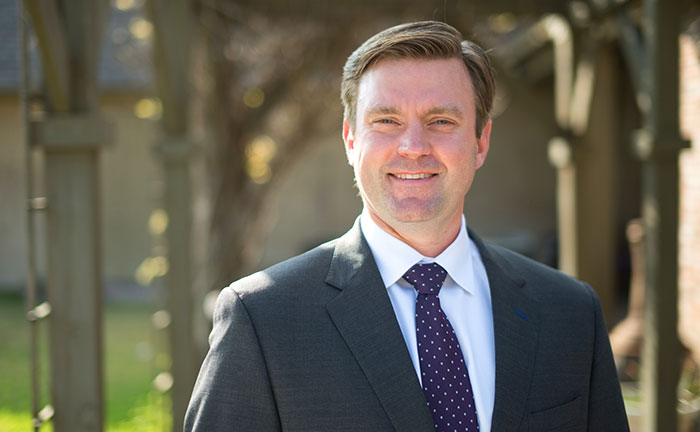The personal approach

Donovan Davis, CFP • Alexandria, LA
Reed Davis Investment Group • LPL Financial
Read full biography below
I appreciate the training I received early in my career, all with very good companies. But my partner and I both decided together that we did not want to be tied into a specific business model or be constrained by proprietary products.
Our mission statement revolves around understanding clients’ specific financial objectives and then providing them with the high-quality resources, information, service, and products that will help them work toward their goals. We think we can best serve that vision as an independent advisory firm.
I think part of my motivation also comes from my personal background. I grew up in a family of modest means. My parents both had some health issues and struggled to make ends meet. I was married early and had children at a young age. I served in the National Guard and was deployed to the Middle East. September 11 and the dot-com bust came shortly after I entered the financial field. All of these factors have given me a seriousness of purpose. They have contributed to my entrepreneurial outlook and the desire to control my own future as much as possible.
How does that carry through to the process you use with clients?
The key is to build a strong relationship from the outset. We spend a lot of time early in the process really getting to know clients on a personal level. What makes them tick? What are their ultimate dreams? What kinds of experiences have they had with their investments and finances in the past?
I am a firm believer in and have a healthy respect for comprehensive financial planning*—but I think it has to be a living and interactive process. A one-time plan that sits on a shelf and collects dust is not very valuable for clients. They have real-life needs and circumstances that are constantly evolving. Their plan has to be proactive, revisited regularly, and revised accordingly. It also has to be more than just an investment plan. I want to understand their insurance requirements, what they have in place for estate planning, their retirement income needs, how they might best claim Social Security, and many other key areas.

Talk about the investment side of the planning process.
My partner and I started implementing a bucket approach to investment planning about five years ago, primarily for clients who are in or facing retirement. We take very minimal risk with funds that might be needed in the short term, implement a fairly conservative investment approach for the intermediate term, and then look toward more growth for longer-term assets. For that growth phase, we tend to use active investment management, which has an objective of smoothing out some of the volatility and drawdowns for a portfolio. But we have found that tactical approaches might fit well for some people in any of the three buckets, and can be used for various asset classes.
The world has changed dramatically over the past 15 or 20 years, and that has affected how we approach the investment side. There is economic risk, geopolitical risk, and market risk. People face unforeseen events in their lives and they face them in the markets. We also have a low-interest-rate environment where the so-called safe investments of the past are no longer delivering adequate returns.
One of my biggest concerns is aligning someone’s risk tolerance with what they are trying to pursue and making sure it is realistic. This needs to happen from both an investment perspective and in terms of fitting their personality type and risk profile. We joke around that we have to be part planner and part psychologist when working with clients—but there is a lot of truth to that. Money is a very personal thing and everyone has uniquely individual needs. My partner and I view it as a very serious responsibility to help people to preserve their assets first, and then to focus on growing them. That is a key reason why we turn to professional money managers who strive to reduce downside risk with active portfolio strategies.
How do you explain your investment approach to clients?
A lot depends on their interest in diving deep into the details of it. Not everyone is interested in getting into the mechanics of something like a Monte Carlo simulation. But, since we are working in partnership with clients on recommendations, education is an important part of the process. Clients need to have a good understanding of the options available to them and why we are recommending a specific course of action.
Central to this is the discussion around risk. We use a sophisticated, quantitative methodology to get at a risk profile that is based on Nobel Prize–winning behavioral economics principles. We can uncover for a new client the risk they are actually taking on in their current portfolio construction versus what is compatible with their objectives, personality, and financial situation. This is often a real eye-opener. People are surprised that age is not the overriding determining factor and that the process considers several different factors. Ultimately, this will lead to portfolio construction that can define a range of probabilities for performance that is in sync with their specific risk outlook and their objectives. As an advisor, that is a tremendous help in defining realistic expectations and helping clients to stick with an investment plan.
Are there any specific educational techniques you use?
I will often go through a broad discussion of risk factors and the real impact they can have on a client’s portfolio. Clients are exposed in the media to the concept that the S&P 500, the Dow Jones Industrial Average, or other indexes define the market and represent how they should be thinking about benchmarks. Nothing could be further from the truth. Again, they should be evaluating portfolio performance using realistic objectives and expectations that align with their goals over the long term.
They also have been exposed to the concept, and supposed wisdom, of buy-and-hold investing—especially during the current bull market. It is amazing to me how short memories can be. I frequently go through charts and illustrations showing the cyclical nature of the markets over time, and the havoc that bear markets can bring to a portfolio. For example, if an investor gains 30% in one year and then loses 50% the next year, how long does it take to return to the original account balance? Then I will show how account withdrawals during retirement can add another element that makes large portfolio drawdowns using only a buy-and-hold strategy very problematic.
The sequence of returns sounds like a sophisticated concept but it is extremely important and can be explained in simple terms. When I show clients a visual picture of that, and the mathematics involved, it really resonates with most people. This helps us get on the same page when talking about risk management and why active, tactical management can be a valuable tool. There may be a place in portfolios for some passive investments, but they need a well-defined role in the overall allocation strategy and work hand-in-hand with more active strategies.
The bottom line is that we will do whatever it takes to try to help our clients succeed in planning out their financial future. Education is key to that, and we implement a regular stream of client communications. We also try to get to know our clients outside of the office environment, and we host a number of client appreciation and social events. We owe the success of our firm to our clients. Those relationships are very important to us, both professionally and personally.
*Financial planning offered through LPL Financial, a registered investment advisor.
 Donovan Davis is a registered representative with LPL Financial and a partner at Reed Davis Investment Group, based in Alexandria, Louisiana. Mr. Davis and his team specialize in investment, retirement, and estate planning.
Donovan Davis is a registered representative with LPL Financial and a partner at Reed Davis Investment Group, based in Alexandria, Louisiana. Mr. Davis and his team specialize in investment, retirement, and estate planning.
Mr. Davis grew up in Alexandria and attended Louisiana Tech University. During college, he joined the National Guard, working as an engineer during and after his deployment to Afghanistan. After earning his degree in accounting, Mr. Davis worked as a financial consultant for many well-known investment and wealth-management companies before becoming a partner is his current private practice. Mr. Davis is a Certified Financial Planner (CFP®) and his Series 7 and 66 securities registrations are held with LPL Financial.
“I count my blessings to be in this business—to be able to help people who have worked hard all of their lives to preserve their money and manage their risk. It’s important to me that my clients don’t worry about whether they will run out of money when they’re 85,” says Mr. Davis.
When not spending time with his family, Mr. Davis enjoys tennis, golf, and long-distance running with his wife. “My wife and I are very competitive. She beat my time in a race we recently ran by 30 seconds, which means it’s time to get my sneakers on!” Mr. Davis and his family are active in their church, where they frequently volunteer. He is also on the board of directors of the Children’s Advocacy Network, an organization that helps neglected and abused children get through the welfare and judicial systems.
Disclosure: Donovan Davis is a Registered Representative with and Securities and Advisory services offered through LPL Financial, a registered investment advisor. Member FINRA & SIPC. Investing involves risk, including potential loss of principal. No strategy ensures success or protects against a loss. All indices referenced are managed and may not be invested into directly. Reed Davis Investment Group is a separate unaffiliated entity from LPL Financial.
Photography by Jason Cohen


